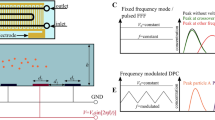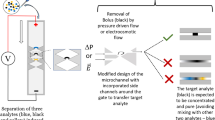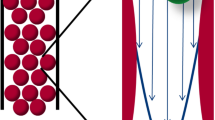Abstract
The development of insulator-based dielectrophoresis chromatography is proposed here as a novel hybrid technique that capitalizes on the simplicity of insulator-based dielectrophoresis (iDEP) and the well-known chromatographic theory. Chromatographic parameters are employed to characterize dielectrophoretic separation of particles with particles being eluted from the system as enriched particle peaks. By varying the characteristics of the insulating posts, it was possible to manipulate the interactions of the particles with the insulating post array which acted as the stationary phase. The present work studied how the characteristics of the particles affected the particle retention. Different types of particles have distinct interactions with the post array; these interactions depend on particle properties (size, electrical charge, and polarizability). This work includes mathematical modeling with COMSOL and extensive experimentation. Particles ranging from 1 to 10 μm in diameter were tested for retention time and eluted as peaks in the iDEP chromatography devices. Separation results were reported in the form of dielectropherograms including the estimation of retention time (tR), separation efficiency (N/meter), and separation resolution (Rs). Two full separations were demonstrated: a separation by charge between two types of particles of similar size (~ 10 μm) with different electrical surface charges and a separation by size between 2- and 5-μm particles with similar surface charge (difference in ζP of 4 mV). The achieved separation resolutions were Rs = 1.8 and Rs = 3.5, respectively. This is the first study on DEP chromatography to assess performance in terms of resolution and separation efficiency, demonstrating the unique potential of iDEP chromatography.





Similar content being viewed by others
References
Su W, Gao X, Jiang L, Qin J. Microfluidic platform towards point-of-care diagnostics in infectious diseases. J Chromatogr A. 2015;1377:13–26.
Lapizco-Encinas BH. Chapter 7. Applications of dielectrophoresis in microfluidics. In: Microfluidics in detection science: lab-on-a-chip technologies. Cambridge: The Royal Society of Chemistry; 2015. p. 192–223.
Pethig R. Review—Where is dielectrophoresis (DEP) going? J Electrochem Soc. 2017;164(5):B3049–B55.
Abd Rahman N, Ibrahim F, Yafouz B. Dielectrophoresis for biomedical sciences applications: a review. Sensors. 2017;17(3):449.
Pohl HA. The motion and precipitation of suspensoids in divergent electric fields. J Appl Phys. 1951;22(7):869–71.
Cummings EB, Singh AK. Dielectrophoretic trapping without embedded electrodes. Proceedings of SPIE: Conference on Microfluidic Devices and Systems III; 2000; Santa Clara, CA.
Nakano A, Ros A. Protein dielectrophoresis: advances, challenges, and applications. Electrophoresis. 2013;34(7):1085–96.
Mata-Gomez MA, Perez-Gonzalez VH, Gallo-Villanueva RC, Gonzalez-Valdez J, Rito-Palomares M, Martinez-Chapa SO. Modelling of electrokinetic phenomena for capture of PEGylated ribonuclease a in a microdevice with insulating structures. Biomicrofluidics. 2016;10(3):033106.
Liao KT, Chou CF. Nanoscale molecular traps and dams for ultrafast protein enrichment in high-conductivity buffers. J Am Chem Soc. 2012;134(21):8742–5.
Gallo-Villanueva RC, Rodríguez-López CE, Díaz-de-la-Garza RI, Reyes-Betanzo C, Lapizco-Encinas BH. DNA manipulation by means of insulator-based dielectrophoresis employing direct current electric fields. Electrophoresis. 2009;30(24):4195–205.
Jones PV, Salmon GL, Ros A. Continuous separation of DNA molecules by size using insulator-based dielectrophoresis. Anal Chem. 2017;89(3):1531–9.
Rohani A, Moore JH, Kashatus JA, Sesaki H, Kashatus DF, Swami NS. Label-free quantification of intracellular mitochondrial dynamics using dielectrophoresis. Anal Chem. 2017;89(11):5757–64.
Luo J, Muratore KA, Arriaga EA, Ros A. Deterministic absolute negative mobility for micro- and submicrometer particles induced in a microfluidic device. Anal Chem. 2016;88(11):5920–7.
Ding J, Lawrence RM, Jones PV, Hogue BG, Hayes MA. Concentration of Sindbis virus with optimized gradient insulator-based dielectrophoresis. Analyst. 2016;141(6):1997–2008.
Braff WA, Willner D, Hugenholtz P, Rabaey K, Buie CR. Dielectrophoresis-based discrimination of bacteria at the strain level based on their surface properties. PLoS One. 2013;8(10):e76751.
Jones P, DeMichele A, Kemp L, Hayes M. Differentiation of Escherichia coli serotypes using DC gradient insulator dielectrophoresis. Anal Bioanal Chem. 2014;406(1):183–92.
Su Y-H, Tsegaye M, Varhue W, Liao K-T, Abebe LS, Smith JA, et al. Quantitative dielectrophoretic tracking for characterization and separation of persistent subpopulations of Cryptosporidium parvum. Analyst. 2014;139(1):66–73.
Kwon J-S, Maeng J-S, Chun M-S, Song S. Improvement of microchannel geometry subject to electrokinesis and dielectrophoresis using numerical simulations. Microfluid Nanofluid. 2008;5(1):23–31.
Gencoglu A, Olney D, LaLonde A, Koppula KS, Lapizco-Encinas BH. Particle manipulation in insulator based dielectrophoretic devices. J Nanotech Eng Med. 2013;4(2):021002.1–7.
LaLonde A, Gencoglu A, Romero-Creel MF, Koppula KS, Lapizco-Encinas BH. Effect of insulating posts geometry on particle manipulation in insulator based dielectrophoretic devices. J Chromatogr A. 2014;1344:99–108.
Saucedo-Espinosa MA, Lapizco-Encinas BH. Design of insulator-based dielectrophoretic devices: effect of insulator posts characteristics. J Chromatogr A. 2015;1422:325–33.
Pesch GR, Kiewidt L, Du F, Baune M, Thöming J. Electrodeless dielectrophoresis: impact of geometry and material on obstacle polarization. Electrophoresis. 2016;37(2):291–301.
Mohammadi M, Zare MJ, Madadi H, Sellarès J, Casals-Terré J. A new approach to design an efficient micropost array for enhanced direct-current insulator-based dielectrophoretic trapping. Anal Bioanal Chem. 2016;408(19):5285–94.
Deinhammer RS, Ting E-Y, Porter MD. Dynamic modification of separations using electrochemically modulated liquid chromatography. Anal Chem. 1995;67(2):237–46.
Harnisch JA, Porter MD. Electrochemically modulated liquid chromatography: an electrochemical strategy for manipulating chromatographic retention. Analyst. 2001;126(11):1841–9.
Breadmore MC. Recent advances in enhancing the sensitivity of electrophoresis and electrochromatography in capillaries and microchips. Electrophoresis. 2007;28(1–2):254–81.
Castro ER, Manz A. Present state of microchip electrophoresis: state of the art and routine applications. J Chromatogr A. 2015;1382:66–85.
Terabe S. Peer reviewed: micellar electrokinetic chromatography. Anal Chem. 2004;76(13):240 A–6 A.
Holmes D, Morgan H. Dielectrophoretic chromatography of cells. In: Baba Y, Shoji S, Berg A, editors. Micro total analysis systems. Dordrecht: Springer; 2002. p. 829–31.
Washizu M, Suzuki S, Kurosawa O, Nishizaka T, Shinohara T. Molecular dielectrophoresis of biopolymers. IEEE Trans Ind Appl. 1994;30(4):835–43.
Kawabata T, Washizu M. Dielectrophoretic detection of molecular bindings. IEEE Trans Ind Appl. 2001;37(6):1625–33.
Sano H, Kabata H, Kurosawa O, Washizu M. Dielectrophoretic chromatography with cross-flow injection. MEMS 2002 IEEE International Conference Fifteenth IEEE International Conference on Micro Electro Mechanical Systems 2002. p 11–4.
Kikkeri K, Ngu B, Agah M. Submicron dielectrophoretic chromatography. 2018 IEEE Micro Electro Mechanical Systems (MEMS); 2018.
Giesler J, Pesch GR, Weirauch L, Schmidt M-P, Thoming J, Baune M. Dielectrophoretic particle chromatographie (DPC) at preparative scale 2019; Available from: https://www.uni-bremen.de/en/cvt/research/particle-separation/dielectrophoretic-particle-chromatography/. Accessed 10 Oct 2019.
LaLonde A, Romero-Creel MF, Saucedo-Espinosa MA, Lapizco-Encinas BH. Isolation and enrichment of low abundant particles with insulator-based dielectrophoresis. Biomicrofluidics. 2015;9(6):064113.
Lapizco-Encinas BH. On the recent developments of insulator-based dielectrophoresis: a review. Electrophoresis. 2019;40(3):358–75.
Cummings EB. Streaming dielectrophoresis for continuous-flow microfluidic devices. IEEE Eng Med Biol Mag. 2003;22(6):75–84.
Xuan X. Curvature-induced dielectrophoresis. In: Li D, editor. Encyclopedia of microfluidics and nanofluidics. New York: Springer New York; 2015. p. 515–20.
Saucedo-Espinosa MA, LaLonde A, Gencoglu A, Romero-Creel MF, Dolas JR, Lapizco-Encinas BH. Dielectrophoretic manipulation of particle mixtures employing asymmetric insulating posts. Electrophoresis. 2016;37(2):282–90.
Jones TB. Electromechanics of particles. New York: Cambridge University Press; 1995.
Romero-Creel M, Goodrich E, Polniak D, Lapizco-Encinas B. Assessment of sub-micron particles by exploiting charge differences with dielectrophoresis. Micromachines. 2017;8(8):239–53.
Zhao H. On the effect of hydrodynamic slip on the polarization of a nonconducting spherical particle in an alternating electric field. Phys Fluids. 2010;22(7):072004.
Cummings EB, Singh AK. Dielectrophoresis in microchips containing arrays of insulating posts: theoretical and experimental results. Anal Chem. 2003;75(18):4724–31.
Hill N, Lapizco-Encinas BH. On the use of correction factors for the mathematical modeling of insulator based dielectrophoretic devices. Electrophoresis. 2019;40(18–19):2541–52.
Weiss NG, Jones PV, Mahanti P, Chen KP, Taylor TJ, Hayes MA. Dielectrophoretic mobility determination in DC insulator-based dielectrophoresis. Electrophoresis. 2011;32(17):2292–7.
Duffy DC, McDonald JC, Schueller OJA, Whitesides GM. Rapid prototyping of microfluidic systems in poly(dimethylsiloxane). Anal Chem. 1998;70(23):4974–84.
Saucedo-Espinosa MA, Lapizco-Encinas BH. Refinement of current monitoring methodology for electroosmotic flow assessment under low ionic strength conditions. Biomicrofluidics. 2016;10(3):033104.
Hidalgo-Caballero S, Lentz CJ, Lapizco-Encinas BH. Assessment of submicron particle zeta potential in simple electrokinetic microdevices. Electrophoresis. 2019;40(10):1395–9.
Martínez-López JI, Moncada-Hernández H, Baylon-Cardiel JL, Martínez-Chapa SO, Rito-Palomares M, Lapizco-Encinas BH. Characterization of electrokinetic mobility of microparticles in order to improve dielectrophoretic concentration. Anal Bioanal Chem. 2009;394(1):293–302.
Arnold WM, Schwan HP, Zimmermann U. Surface conductance and other properties of latex particles measured by electrorotation. J Phys Chem. 1987;91(19):5093–8.
Lapizco-Encinas BH, Ozuna-Chacón S, Rito-Palomares M. Protein manipulation with insulator-based dielectrophoresis and DC electric fields. J Chromatogr A. 2008;1206(1):45–51.
Beckman J, Song Y, Gu Y, Voronov S, Chennamsetty N, Krystek S, et al. Purity determination by capillary electrophoresis sodium hexadecyl sulfate (CE-SHS): a novel application for therapeutic protein characterization. Anal Chem. 2018;90(4):2542–7.
Leclercq L, Morvan M, Koch J, Neusüß C, Cottet H. Modulation of the electroosmotic mobility using polyelectrolyte multilayer coatings for protein analysis by capillary electrophoresis. Anal Chim Acta. 2019;1057:152–61.
Acknowledgments
The authors are grateful to Danielle Polniak for the experimental support.
Funding
This work was supported by the National Science Foundation (Award CBET-1705895).
Author information
Authors and Affiliations
Corresponding author
Ethics declarations
Conflict of interest
The authors declare that they have no competing interests.
Ethical approval
This article does not contain any studies with human participants or animals.
Informed consent
Informed consent is not applicable in this study.
Additional information
Published in the topical collection Bioanalytics and Higher Order Electrokinetics with guest editors Mark A. Hayes and Federica Caselli.
Publisher’s note
Springer Nature remains neutral with regard to jurisdictional claims in published maps and institutional affiliations.
Electronic supplementary material
ESM1
(PDF 909 kb)
Rights and permissions
About this article
Cite this article
Hill, N., Lapizco-Encinas, B.H. Continuous flow separation of particles with insulator-based dielectrophoresis chromatography. Anal Bioanal Chem 412, 3891–3902 (2020). https://doi.org/10.1007/s00216-019-02308-w
Received:
Revised:
Accepted:
Published:
Issue Date:
DOI: https://doi.org/10.1007/s00216-019-02308-w




